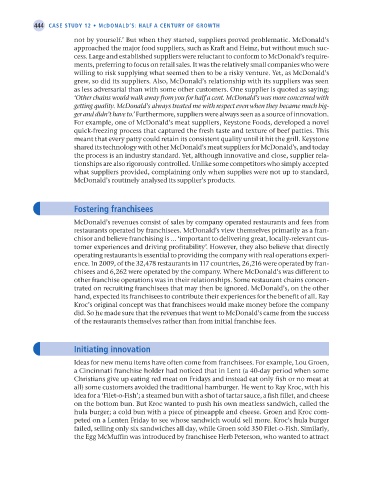Page 469 - Operations Strategy
P. 469
444 case study 12 • McDONALD’S: hALf A ceNtury Of grOwth
not by yourself.’ But when they started, suppliers proved problematic. McDonald’s
approached the major food suppliers, such as Kraft and Heinz, but without much suc-
cess. Large and established suppliers were reluctant to conform to McDonald’s require-
ments, preferring to focus on retail sales. It was the relatively small companies who were
willing to risk supplying what seemed then to be a risky venture. Yet, as McDonald’s
grew, so did its suppliers. Also, McDonald’s relationship with its suppliers was seen
as less adversarial than with some other customers. One supplier is quoted as saying;
‘Other chains would walk away from you for half a cent. McDonald’s was more concerned with
getting quality. McDonald’s always treated me with respect even when they became much big-
ger and didn’t have to.’ Furthermore, suppliers were always seen as a source of innovation.
For example, one of McDonald’s meat suppliers, Keystone Foods, developed a novel
quick-freezing process that captured the fresh taste and texture of beef patties. This
meant that every patty could retain its consistent quality until it hit the grill. Keystone
shared its technology with other McDonald’s meat suppliers for McDonald’s, and today
the process is an industry standard. Yet, although innovative and close, supplier rela-
tionships are also rigorously controlled. Unlike some competitors who simply accepted
what suppliers provided, complaining only when supplies were not up to standard,
McDonald’s routinely analysed its supplier’s products.
fostering franchisees
McDonald’s revenues consist of sales by company operated restaurants and fees from
restaurants operated by franchisees. McDonald’s view themselves primarily as a fran-
chisor and believe franchising is … ‘important to delivering great, locally-relevant cus-
tomer experiences and driving profitability’. However, they also believe that directly
operating restaurants is essential to providing the company with real operations experi-
ence. In 2009, of the 32,478 restaurants in 117 countries, 26,216 were operated by fran-
chisees and 6,262 were operated by the company. Where McDonald’s was different to
other franchise operations was in their relationships. Some restaurant chains concen-
trated on recruiting franchisees that may then be ignored. McDonald’s, on the other
hand, expected its franchisees to contribute their experiences for the benefit of all. Ray
Kroc’s original concept was that franchisees would make money before the company
did. So he made sure that the revenues that went to McDonald’s came from the success
of the restaurants themselves rather than from initial franchise fees.
Initiating innovation
Ideas for new menu items have often come from franchisees. For example, Lou Groen,
a Cincinnati franchise holder had noticed that in Lent (a 40-day period when some
Christians give up eating red meat on Fridays and instead eat only fish or no meat at
all) some customers avoided the traditional hamburger. He went to Ray Kroc, with his
idea for a ‘Filet-o-Fish’; a steamed bun with a shot of tartar sauce, a fish fillet, and cheese
on the bottom bun. But Kroc wanted to push his own meatless sandwich, called the
hula burger; a cold bun with a piece of pineapple and cheese. Groen and Kroc com-
peted on a Lenten Friday to see whose sandwich would sell more. Kroc’s hula burger
failed, selling only six sandwiches all day, while Groen sold 350 Filet-o-Fish. Similarly,
the Egg McMuffin was introduced by franchisee Herb Peterson, who wanted to attract
Z12 Operations Strategy 62492.indd 444 02/03/2017 13:56

